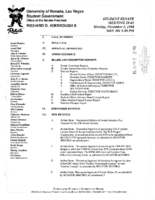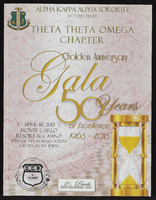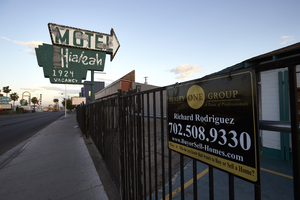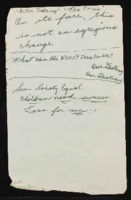Search the Special Collections and Archives Portal
Search Results

Meeting minutes for Consolidated Student Senate University of Nevada, Las Vegas, November 2, 1998
Date
Archival Collection
Description
Text

Theta Theta Omega, 50th Golden Anniversary Gala (Monte Carlo Hotel)
Date
Archival Collection
Description
From the Alpha Kappa Alpha Sorority, Incorporated, Theta Theta Omega Chapter Records (MS-01014) -- Ivy Leaf magazines and event souvenir programs file.
Text

Photographs of Hialeah Motel sign, Las Vegas (Nev.), April 18, 2017
Date
Archival Collection
Description
Site address: 1924 Fremont St
Sign owner: La Jolla Development Group, LLC
Sign details: The current building was constructed in 1951 (Assessor). One source states that Tinkler's Motel may have been open on the site in the 1940's (VintageVegas.com, n.d.). A vintage postcard circa late 1940's-early 1950's advertises "Tinkler's Motel Hialeah", although the sign shown in the photograph states" Tinkler's Motel" (CardCow.com, n.d.). A vintage postcard circa 1950's-early 1960's shows the current name,"Hialeah Motel" (Las Vegas motels then and now, n.d.).
Sign condition: Condition is 3, fair. The cabinets are intact with no major rust damage. On the east side of the sign, the paint is flaking moderately on the upper arrow cabinet. On the west side, the paint is flaking severely on the upper arrow cabinet as well as the lower cabinet. Most of the incandescent light bulbs around the upper cabinet remain. All of the neon tubes are gone from both the lower and upper cabinets.
Sign form: Pole sign
Sign-specific description: The lower cabinet is shaped like three rectangles stacked upward in increasing size. The pole runs through the cabinet, which is cantilevered toward the street. The upper cabinet is shaped like an arrow pointed at the motel. The pole and lower cabinet are painted forest green. On the lower cabinet, hand painted sans serif letters state, "Hialeah 1924 VACANCY". The exterior of the upper arrow-shaped cabinet is painted black. The interior is white. The cabinet is channeled and holes for neon tubing are evident, but no neon remains. Yellow incandescent light bulbs outline the exterior of the cabinet. At the center of the pole on the hotel side is a horizontal pole from which a small sign may have hung previously.
Sign - type of display: Incandescent light bulbs, but the sign also had neon tubing at one time.
Sign - media: Steel
Sign - non-neon treatments: Incandescent light bulbs
Sign environment: This is located on East Fremont and has many other motels surrounding it though many of the neighboring motels are shut down.
Sign - date of installation: Possibly 1940's, likely circa 1950's-1960's
Sign - date of redesign/move: A vintage postcard circa late 1940's-early 1950's (CardCow.com, n.d.) shows a small sign which has either been replaced or modified over time. The sign consists of three cabinets mounted symmetrically on a pole. The lower cabinet is painted white and states, "AIR CONDITIONED" or "AIR CONDITIONER". The large central cabinet is black and states, "MOTEL". The smaller upper cabinet is painted black and advertises, "Tinkler's". A vintage postcard circa 1950's-early 1960's (Las Vegas motels then and now, n.d.). shows the current pole and cantilevered lower cabinet without the upper arrow-shaped cabinet. On the lower hotel side of the sign hangs a small yellow sign. Some or all of the lettering is traced with neon letters. By the late 1980's, the motel arrow had been added (VintageLasVegas.com, 2017). "MOTEL" is spelled out in red neon inside the channel of the arrow. The lower cabinet is painted green. "T.V." is spelled in black sans serif letters outlined in white. "Hialeah" is painted in white sans serif letters traced by clear neon letters. Below Hialeah is illegible clear neon, possibly "AIR CONDITIONING" or "AIR CONDITIONER". At the bottom of the lower cabinet "HAMBURGERS", "HOT DOGS" and "VACANCY" are spelled out in white san serif letters. A photograph taken sometime between the 1980's and 2008 (Jacobson, n.d.) shows the lettering on the lower cabinet simplified to the current design, except "T.V." is still painted to the left of "HIALEAH". Three yellow skeleton neon waves underline "T.V." and two more indistinguishable neon tubes of the same type sit over the "T". Some neon around "HIALEAH"in the lower cabinet and all of the neon around "MOTEL"in the upper arrow-shaped cabinet remain. By 2008, the sign had reached its current design (Las Vegas motels then and now, n.d.).
Sign - thematic influences: Horseracing (the motel name references Hialeah Park Racetrack in Hialeah, Florida; vintage postcard shows grass and racetrack type fencing [Las Vegas motels then and now, n.d.])
Sign - artistic significance: This location maintains the Horse Racing theme with their name. They also showcase 1940's (possibly), 1950's-1960's eras themes with emergence and prominence of the motor courts during those eras.
Survey - research locations: CardCow.com. (n.d.). Tinler's [sic] Motel Hialeah. Retrieved from https://www.cardcow.com/281785/tinlers-motel-hialeah-las-vegas-nevada/ Clark County Assessor, parcel no. 139-35-803-004. Retrieved from http://www.clarkcountynv.gov/assessor/Pages/PropertyRecords.aspx?H=redrock&P=assrrealprop/pcl.aspx Jacobson, J. (n.d.). Hialeah Motel [private image, copyright applies]. Retrieved from http://www.pbase.com/easystreet/image/103828763 Las Vegas motels then and now. (n.d.). 15: Hialeah Motel. Retrieved from http://stefanidrivesvegas.com/2.html VintageLasVegas.com. (n.d.). Downtown Las Vegas hotels & casinos 1931-2000. Retrieved from http://vintagelasvegas.com/downtown VintageLasVegas.com. (2017 February 2). Hialeah Motel. Retrieved from http://vintagelasvegas.com/tagged/Hialeah-Motel
Surveyor: Mitchell Cohen
Survey - date completed: 2017-08-23
Sign keywords: Neon; Incandescent; Steel; Pole sign; Directional
Mixed Content

Las Vegas branch NAACP records: documents, correspondence
Date
Archival Collection
Description
Folder of materials from the Mabel Hoggard Papers (MS-00565) -- Civic engagement file. National Association for the Advancement of Colored People (NAACP) certificate, journal, radio script, program booklets, and correspondence. This folder includes a policy statement of the NAACP, certificate of merit, education department features booklet, Gala Celebration and Awards Banquet booklets, and NAACP Historical Committee documents.
Mixed Content

Transcript of interview with Peggy Huber by Greg Pushard, March 14, 1981
Date
Archival Collection
Description
On March 14th, 1981, collector Greg Pushard interviewed postmaster Peggy Huber (born March 31st, 1884 in Conway, Arkansas) in her home in Las Vegas, Nevada. This interview covers Peggy’s life in Nevada and also offers an insightful overview of Nevada’s rich history. During this interview Peggy discusses life on the ranch, mining, settlement, and the local early aboveground atomic blasts.
Text

Virginia T. Lanier interview, March 16, 1981: transcript
Date
Archival Collection
Description
From the Ralph Roske Oral History Project on Early Las Vegas collection OH-01060. On March 16, 1981, collector Heidi G. Hughes speaks to Virginia T. Lanier at the collector’s home in Las Vegas, Nevada. Lanier talks about living on the Strip in Las Vegas, Nevada in the 1950’s and 1960’s. She speaks about her experiences riding the bus, working in food service, and what the Strip was like during the time period.
Text

Transcript of interview with Frank Cope by Marianne Johnson, March 15, 1978
Date
Archival Collection
Description
Text

Transcript of interview with Harvey N. Dondero by Iskander A. Batlouni, February 26, 1981
Date
Archival Collection
Description
Text

Transcript of interview with Jacqueline Evans by Susan Rapport, March 15, 1981
Date
Archival Collection
Description
On March 15, 1981, Susan Rapport interviewed Jacqueline Evans (born 1940 in Long Beach, California) about her experiences in Nevada. Evans first talks about living in Reno and Tonopah before moving to Las Vegas where she attended high school. She talks specifically about her extracurricular activities in high school, recreational activities, and other forms of entertainment. The two also discuss political events during the sixties, her husband’s involvement in Indian affairs, and the flood problem in Las Vegas. Evans also talks about bringing children up in Las Vegas, camping as a recreational activity, and the development of Lake Mead.
Text

